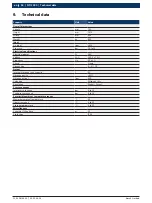
F 002 DG9 A00
2013-04-16
|
Bosch Limited
Product description | N�� ���� | 7
N�� ���� | 7
| 7
en
1
2
3
4
5
6
7
8
9
10
A002_31
Fig. 2:
Side view of NTI 1000
1 Filter Regulator Combination (FRC)
2 Product nameplate
3 Hose holder
4 Inlet for external nitrogen tank
5 Outlet for external nitrogen tank
6 Exhaust for air/nitrogen
7 Power socket
8 Digital port for inflation/deflation
9 Direct inlet for inflation
10 Digital port for inflation/deflation
2
3
1
4
A001_
3
Fig. 3:
Internal view of NTI 1000
1 Nitrogen tank
2 Manifold valves
3 Vacuum pump (optional)
4 CMS tanks
�.5
Description of function
The NTI 1000 works on the principle of Pressure Swing
Adsorption (PSA). PSA is a regenerative process of gen-
erating nitrogen from compressed air.
Compressed air is supplied through a pneumatic line
connected to a Filter Regulator Combination (FRC)
where moisture, oil and particulate matter are filtered.
Based on their molecular characteristics, compressed
gases have a tendency to adhere to solid surfaces
known as "adsorbents". The process of compressed
gases adhering to adsorbents is known as "adsorption".
When the compressed air is passed through a tank
with a Carbon Molecular Sieve (CMS), the molecules of
oxygen are adsorbed by activated carbon, which is an
adsorbent. The adsorbed gases are let out to the at-
mosphere. During this phase pressurized air is let into
another tank. Again, the oxygen molecules are adsorbed
in the CMS. The nitrogen is collected in a tank for inflat-
ing the tires. The nitrogen thus produced has a purity of
about 95 to 99%.
The toggle switch (Fig. 1, Pos. 8) can be used to select
air or nitrogen filling. The selected gas is filled into the
vehicle tire through a filling hose. The NTI 1000 should
be supplied with a constant supply of compressed air in
the range of 10 bar to 16 bar.
Summary of Contents for NTI 1000
Page 1: ...NTI 1000 en Original instructions Nitrogen tire inflator ...
Page 2: ......
Page 19: ......






































